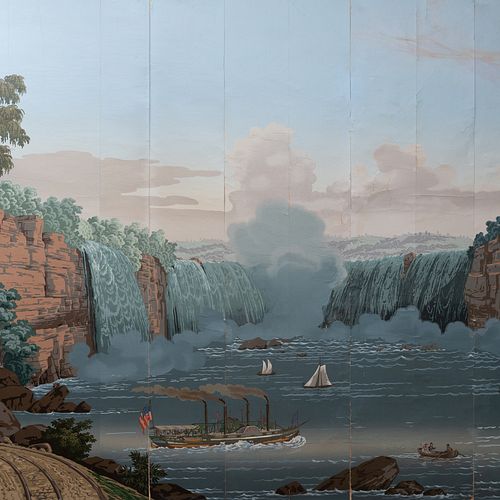Jean Zuber and Co., Vues d'Amérique du Nord (Views of North America) Panoramic Wallpaper Panels, after Jean-Julien Deltil (1791-1863)
Bid Increments
| Price | Bid Increment |
|---|---|
| $0 | $25 |
| $200 | $50 |
| $500 | $100 |
| $3,000 | $250 |
| $5,000 | $500 |
| $10,000 | $1,000 |
| $30,000 | $2,500 |
| $100,000 | $5,000 |
The set of twenty-seven woodblock panels printed in colors on heavy paper.
Overall approximately 79 x 441 in. (sheet), unframed.
Note: The Zuber Manufactory printed these popular scenes of North America beginning in 1834 using antique woodblocks that dated from 1690. The company has continued to print these panels through to the present day. The full panoramic view contains thirty-two panels printed from 1,690 woodblocks using over two-hundred different colors. The scenes depicted, based on original works by Deltil, are those that were admired most by Europeans in the early nineteenth century: the Natural Bridge of Virginia, Niagara Falls, New York Bay, West Point and Boston Harbor. Widely assumed that these scenes wholly depict American landscapes, wallpaper historian Catherine Lynn has noted that some details in the compositions bear close resemblance to European ports. The wallpaper was imported from France to the United States in the nineteenth century and was not intended solely for upper class houses, though the most famous installation of the Zuber panels is in the White House. First Lady Jacqueline Kennedy salvaged a set of Views of North America panels from a Maryland house that was being demolished, installing them on the west side of the Diplomatic Reception Room. In 1852, Zuber republished Views of North America as The War of American Independence, substituting figures in various scenes to recreate battles and the Boston Tea Party. Mrs. Kennedy used the 1852 wallpaper panels in her redecoration of the White House private dining room. Betty Ford disliked the battle scenes and had them removed, painting the room bright yellow instead. The Carters then rehung the War of American Independence panels and they remained in the dining room until the Clintons chose to cover the walls with pale green silk. The original set of the Views of North America remain today in the Diplomatic Reception Room where it offers foreign diplomats and guests an historical view of America.
































